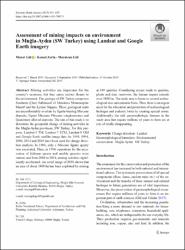Assessment of mining impacts on environment in Mula-Aydn (SW Turkey) using Landsat and Google Earth imagery
Abstract
Mining activities are important for the country's economy, but they cause serious threats to the environment. The geology of SW Turkey comprises Southern (Cine) Submassif of Menderes Metamorphic Massif and the Lycian Nappes. These geological units are unconformably overlain by lignite-bearing Miocene deposits, Upper Miocene-Pliocene conglomerates and Quaternary alluvial deposits. The aim of this study is to determine the geospatial change of mining activities in the Mula-Aydn provinces, SW Turkey. For this purpose, Landsat-5 TM, Landsat-7 ETM, Landsat-8 OLI and Google Earth satellite image data for 1984, 1994, 2004, 2014 and 2018 have been used for change detection analysis. In 1984, only a Miocene lignite quarry was excavated. Then, in 1994, operations for the excavation of feldspar-quartz and marble quarries were started, and from 2004 to 2014, mining activities significantly accelerated. An aerial image of 2018 shows that an area of about 3800 ha has been exploited by mining at 149 quarries. Considering access roads to quarries, plants and dam reservoirs, the human impact extends over 3800 ha. The study area is home to several archaeological sites and endemic biota. Thus, there is an urgent need for the relocation and protection of archaeological heritages and endemic biota by creating special zones. Additionally, the rich geomorphologic features in the study area that require millions of years to form are at risk of totally disappearing.


















